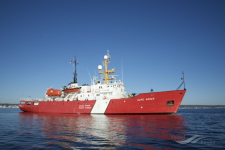The AOP's are important to our Sovereignty needs in the Arctic, they certainly give the RCN the abilty to go further north, go earlier and stay later than ever before. Their primary taskings as I see it our, Presence patrols, SAR and joint exercises with other departments and other Northern governments.
Our main threat to our sovereignty are the US, China and Russia. We have already dealt with pesky Danes and their demands for Danewhiskey. so that front should be quiet for a long time. The US vs Canada will be a political/diplomatic solution (Agreeing to disagree politely).
I don't see the Chinese or Russians acting singularly, but in concert. As I mentioned the Russians have the capability to place and sustain a civilian (in matching Arctic camo) presence on the edge of our archipelago almost at anytime of the year. This will be accompanied by heavy diplomatic assaults on Canada's Arctic claims. If we have a similar government as we have now, it's likley they will be paralyzed and unsure of what to do. giving our opponents time to build their presence and round up support at the UN to challenge our claims.





